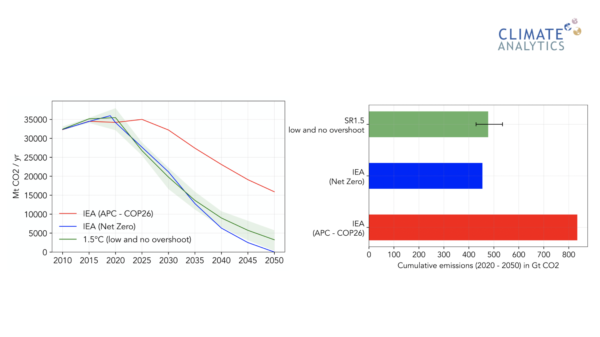1.5°C remains out of reach in the IEA's Announced Pledges Scenario
Authors
Matthew Gidden, Claire Fyson, Carl-Friedrich Schleussner, Gaurav Ganti, Bill Hare
Share

Recent analysis about announcements made at COP26 showed the world could be on track for a 50% chance to limit end-of-century warming to 1.8°C. So why do we need to be cautious?
These reductions in 2100 temperature estimates are largely the result of announced net zero targets for 2050 and beyond. This still leaves an enormous emissions gap in 2030 and is not enough to keep 1.5°C in reach.
In a recently posted analysis, the International Energy Agency (IEA) has estimated that current commitments, many of which are not included in law or official national documents, would give the world a 50% chance of limiting end-of-century warming to 1.8°C, with a one-in-four chance of exceeding 2°C. This is not a Paris Agreement compatible pathway.
Because global warming is tied directly to the total sum of all CO2 emissions, each year of delayed action to 2030 will limit our ability to keep warming to 1.5°C by 2100. The IEA’s Announced Pledges Scenario, mapped in red in the graph below, exceeds the 2030 range of emission levels in 1.5°C compatible pathways by a wide margin, and continues to do so through to mid-century.
Between today and 2050, the IEA 1.8°C pathway emits on average 350 Gt more CO2 than what is observed in IPCC 1.5°C pathways. This would result in a more than 25% chance of a peak warming level above 2°C. This is not compatible with the long-term temperature goal of the Paris Agreement of “holding the increase in the global average temperature to well below 2°C… and pursuing efforts to limit the temperature increase to 1.5°C above pre-industrial levels”.

Delayed action observed in the pledge scenario leads to significant and avoidable warming beyond 1.5°C, which would be crossed sometime in the 2030s. The IPCC has repeatedly confirmed the drastic increases in risks for ecosystems and livelihoods, as well as risks of crossing tipping points if warming was to exceed 1.5°C.
However, we know achieving stringent near-term emission reductions by 2030 could significantly slow down warming over the next 20 years and avoid exceeding 1.5°C altogether.
Paris compatible pathways
The Paris Agreement temperature goal is one goal, and emission pathways compatible with achieving it require a very high chance of limiting warming to below 2°C, while simultaneously keeping 1.5°C within reach. The IPCC Special Report on Global Warming of 1.5°C (SR1.5) scenario provides an assessment and mitigation benchmarks for pathways that are “as likely as not” (between 33% and 66% chance) to limit warming to 1.5°C. These pathways also provide a “very likely” (>90%) or higher chance of holding warming to “well below 2°C”. In these pathways, emissions reduce strongly in the 2020s and 2030s on their way to net zero CO2 by 2050 and net zero greenhouse gases by 2070.
The IEA’s Announced Pledges Scenario does not have these characteristics, and is not compatible with the Paris Agreement’s long-term temperature goal.
Earlier this year, the IEA itself developed a Paris Agreement compatible Net Zero Scenario (see blue line in the graph above), which demonstrates that strong emissions reductions are not only necessary to achieve the Paris Agreement, but also technologically and economically achievable.
Conclusions
Only stronger mitigation action in the next decade can bring the world on track towards the Paris Agreement.
Our recent report, Closing the Gap, demonstrated that, if the G20 countries aligned their 2030 targets (National Determined Contributions, NDCs) with 1.5°C, and net zero CO2 by mid-century, end-of-century temperature rise could be limited to 1.7°C. Crucially, this scenario involves a substantial narrowing of the 2030 emissions gap and therefore would represent real progress in keeping 1.5°C within reach.
In contrast, the IEA’s Announced Pledges Scenario still leaves an enormous gap in 2030.











